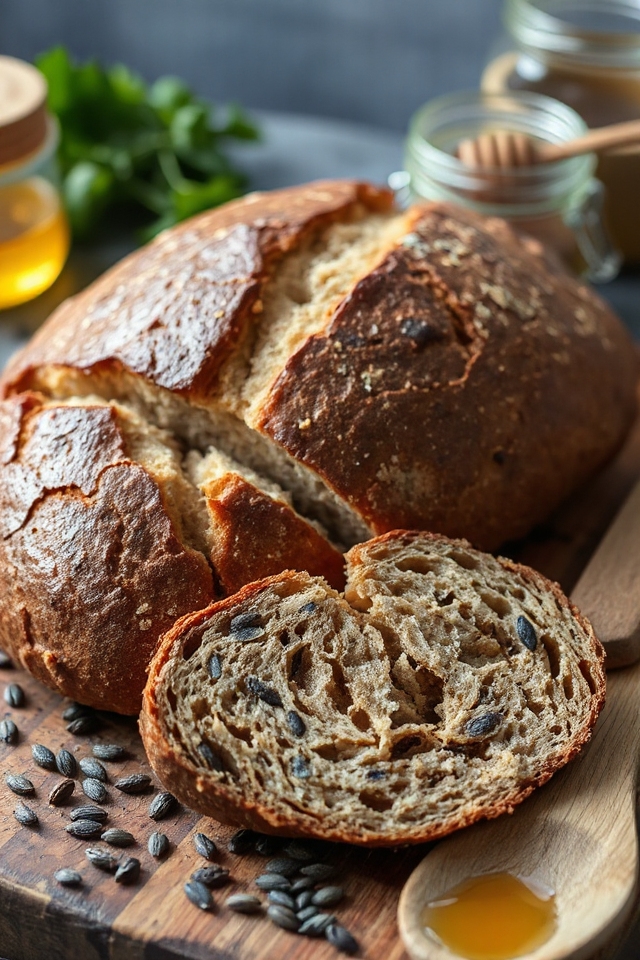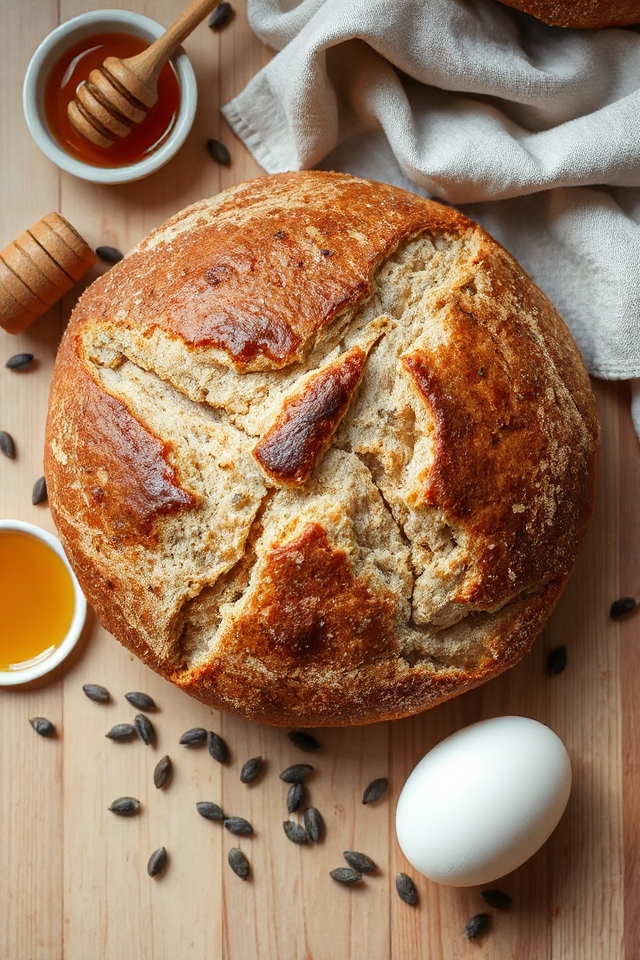Why You’ll Love This Sourdough Rye Bread Recipe
If you’re looking for a bread that’s not only delicious but also packed with character, you’ll love this sourdough rye bread recipe.
The unique blend of flavors from the rye and caraway seeds creates a delightful taste that elevates any meal. I appreciate how the sourdough starter adds a tangy depth, making each slice a treat.
It’s perfect for sandwiches or simply toasted with a bit of butter. Plus, the process of making it feels rewarding, turning simple ingredients into something extraordinary.
Trust me, once you try this bread, you’ll want to make it again and again!
Ingredients of Sourdough Rye Bread
Making sourdough rye bread isn’t just about following a recipe; it’s about creating something that warms your heart and fills your kitchen with an irresistible aroma. The ingredients you’ll need are simple, yet they come together to create a loaf that’s anything but ordinary.
Imagine the nutty flavor of rye, the slight sweetness from honey and molasses, and that delightful tang from the sourdough starter. Trust me, once you’ve gathered everything, you’re one step closer to enjoying this homemade goodness.
Here’s what you’ll need to whip up this scrumptious sourdough rye bread:
- 2 tablespoons oil
- 1 1/2 teaspoons molasses
- 1 1/2 tablespoons honey
- 1 large egg
- 1/3 cup water
- 1 cup sourdough starter
- 2 1/4 cups all-purpose flour (unbleached)
- 3/4 cup rye flour
- 1 1/2 teaspoons salt (or 2 teaspoons kosher salt)
- 2 tablespoons caraway seeds
- 1 1/2 teaspoons instant yeast
- 4 teaspoons essential wheat gluten
Now, as you gather these ingredients, consider the quality of each one. Freshly ground rye flour can add a whole new depth of flavor, and using a robust sourdough starter that’s been well-fed will guarantee your bread rises beautifully.
Don’t skip the essential wheat gluten, especially if you want that lovely chewy texture. And if caraway seeds aren’t your jam, feel free to swap them out for something else or leave them out entirely – but then you’d be missing out on that classic rye flavor. How could you resist?
Just keep in mind, the more love and care you put into selecting your ingredients, the better your bread will turn out. Happy baking!
How to Make Sourdough Rye Bread

Making sourdough rye bread is a delightful adventure, and it all starts with gathering your ingredients. So, roll up your sleeves and let’s plunge into this process.
First off, take your trusty bread machine and add the ingredients in the order your machine prefers. This typically means starting with the liquid ingredients. Pour in 1/3 cup of water, followed by 2 tablespoons of oil, and then add in 1 1/2 teaspoons of molasses and 1 1/2 tablespoons of honey. The sweetness from the honey and molasses will make your bread taste like a warm hug.
Don’t forget to crack in one large egg and toss in 1 cup of your bubbly sourdough starter.
Now, let’s move on to the dry ingredients. In goes 2 1/4 cups of unbleached all-purpose flour, followed by 3/4 cup of rye flour. Sprinkle in 1 1/2 teaspoons of salt (or 2 teaspoons of kosher salt if you’ve got it handy), then add 2 tablespoons of caraway seeds for that classic rye flavor.
Next, toss in 1 1/2 teaspoons of instant yeast and 4 teaspoons of crucial wheat gluten, which is basically the secret weapon for that chewy texture we all love. Now, set your bread machine to the dough setting and let it work its magic.
Peek in after about 10 minutes to see if it’s a bit too dry or too wet—baking is a bit like parenting; sometimes, you just need to adjust and give it a little extra love.
Once the dough has risen and is looking all fluffy and happy, take it out and shape it into whatever form you desire—maybe a loaf, rolls, or even a fancy braid if you’re feeling ambitious.
Give it another rise, then preheat your oven to 350 degrees. After the final rise, score the top with a sharp knife (this is where you can get creative with designs), and pop it in the oven.
Bake for 15 minutes, then turn it around and bake for another 15 minutes. To check for doneness, use an instant-read thermometer; you’re aiming for that sweet spot of 195-200 degrees.
Once it’s done, let it cool completely before slicing—if you can resist that warm, inviting aroma. Enjoy the fruits of your labor, and don’t worry if it’s not perfect; homemade bread is all about the journey, not just the destination.
Sourdough Rye Bread Substitutions & Variations
While I love the classic sourdough rye bread recipe, there are plenty of ways to customize it to suit your taste or dietary needs.
For a gluten-free option, try using a gluten-free flour blend instead of all-purpose flour. If you’re aiming for a nuttier flavor, incorporate whole grain rye flour or add seeds like sunflower or pumpkin.
You can also swap out caraway seeds for fennel or omit them entirely. For a sweeter loaf, mix in dried fruits like raisins or cranberries.
Each variation gives this bread a unique twist, so don’t hesitate to experiment and find your favorite!
Additional Tips & Notes
Customizing your sourdough rye bread can be a fun adventure, but there are also some practical tips to keep in mind for the best results.
First, don’t skip the essential wheat gluten; it really helps with the bread’s structure. If you want a milder flavor, reduce the caraway seeds.
Always check the dough’s consistency during kneading; it should be slightly tacky but not sticky. For a crustier loaf, place a pan of water in the oven while baking.
Finally, let the bread cool completely before slicing. Enjoy experimenting, and remember, practice makes perfect! Happy baking!
